Entries in wind farm property values (118)
9/11/10 Wisconsin Eye hosts panel on wind issues: WeEnergies, WPPI, Vice Chair of Wind-siting council and Wisconsin author weigh in on wind rules.
|
09.10.10 | Newsmakers: Future of Wind Energy |
|---|
|
Wisconsin has more than 300 electricity-generating wind turbines, which can cost up to $4 million each, and developers have plans for hundreds more to meet a requirement that 10% of the state’s energy come from renewable sources by 2015. Although the Public Service Commission has proposed permanent rules on the siting of those turbines, members of the Wind Siting Council, which studied the issue for six months, have warned that they can pose shadow “flicker,” health and property values problems. Wind energy was discussed in a Sept. 10 Newsmakers with Dan Ebert, a vice president of WPPI Energy and former Public Service Commission chairman; Andy Hesselbach, Wind Energy Project Manager for We Energies; Doug Zweizig, Town of Union planning official and Wind Siting Council vice chairman, and Lynda Barry, author now researching a book on homes near turbines. |
|
Watch this program by CLICKING HERE TO LINK TO THIS PROGRAM OR TO BUY A COPY, VISIT THE WISCONSIN EYE WEBSITE BY CLICKING HERE |
WIND TURBINES IN THE NEWS:

WIND TURBINE NOISE, AN INDEPENDENT ASSESSMENT
SOURCE Herald Gazette, knox.villagesoup.com
September 10 2010
By Stephen Ambrose and Robert Rand,
Stephen Ambrose and Robert Rand are members of the Institute of Noise Control Engineering. In 2009, they became concerned about the negative comments from residents living near wind turbine sites and, the apparent lack of regulatory action to address the potential for adverse health impacts from wind turbine generator noise in Mars Hill. They launched their own evaluation, and came to the following conclusions in a series of guest columns.
Wind turbines larger than one megawatt of rated power have become an unexpected surprise for many nearby residents by being much louder than expected.
The sounds produced by blades, gearing, and generator are significantly louder and more noticeable as wind turbine size increases. Long blades create a distinctive aerodynamic sound as air shears off the trailing edge and tip.
The sound character varies from a “whoosh” at low wind speeds to “a jet plane that never lands” at moderate and higher wind speeds. Blade-induced air vortices spinning off the tip may produce an audible “thump” as each blade sweeps past the mast.
Thumping can become more pronounced at distance, described as “sneakers in a dryer,” when sounds from multiple turbines arrive at a listener’s position simultaneously.
Wind turbines are not synchronized and so thumps may arrive together or separately, creating an unpredictable or chaotic acoustic pattern.
The sounds of large industrial wind turbines have been documented as clearly audible for miles. They are intrusive sounds that are uncharacteristic of a natural soundscape.
Studies have shown that people respond to changes in sound level and sound character in a predictable manner. A noticeable change in sound level of 5 decibels (dB) may result in “no response” to “sporadic complaints.” An increase of 10 dB may yield “widespread complaints,”; a 15 dB increase “threats of legal action.”
The strongest negative community response occurs with an increase of 20 dB or more, resulting in “vigorous objections.”
Audible tones, variability in sound level, and an unnatural sound character can amplify the public response. For a distinctive or unpleasant sound, a small change in sound level, or the sound simply being audible, may provoke a strong community response.
Community response can intensify further if sleep is disturbed and quality of life or property is degraded.
Weather conditions influence the sound level generated and how it travels to nearby homes. Sound waves expand outward from the wind turbine with the higher frequencies attenuating at a faster rate than low frequencies.
Locations beyond a few thousand feet may be dominated by low frequency sounds generated by the wind turbines.
Wind turbulence and icing, both common in New England due to topography and latitude, increase aerodynamic noise from intensified or chaotic dynamic stall conditions along the blade surfaces.
Atmospheric conditions at night and downwind enhance sound propagation toward the ground by increasing levels over longer distances.
Wind turbines are elevated hundreds of feet to receive stronger winds yet winds down on the ground or in nearby valleys may be non-existent with correspondingly low background sound levels, accentuating the impact of the intrusive sounds.
Other professionals have developed thresholds, or criteria, for sound level to protect public health that may be applied to planning for wind turbine permitting.
Recommendations from Hayes McKenzie Partnership in 2006 limited maximum wind turbine sound levels at residences to 38 dBA and no more than 33 dBA when “beating noises” are audible when the turbines spin.
Dan Driscoll presented his analysis in 2009 (Environmental Stakeholder Roundtable on Wind Power, June 16, 2009) with a Composite Noise Rating analysis of 33 dBA to reduce rural community response to the level of “sporadic complaints.”
Michael Nissenbaum issued his findings in 2010 from his medical study at Mars Hill, recommending a 7000-foot setback for public health.
The World Health Organization published sound level thresholds of sleep disturbance and adverse health effects from peer-reviewed medical studies (Night Noise Guidelines for Europe, October 2009).
Our next column will compare our sound level versus distance data with these medical, health, and community response criteria and show what distances are necessary to protect public health.
Currently there is no effective, reliable noise mitigation for wind turbines of this size other than shutdown.
Therefore, at this time it appears appropriate that proposed wind turbine sites should position wind turbines at least one mile away from residential properties and further for sites with more than one wind turbine. Smaller wind turbines (under one megawatt power rating) produce less noise than those currently being marketed and installed for grid power in Maine; these may be an option when distance is an issue.
NOTE FROM THE BPWI RESEARCH NERD:
The wind farm mentioned in the following story was cited an example of a successful community wind project by Wind Siting Council member Michael Vickerman
State of Maine finds Fox Island Wind Turbines in violation of noise standard
In a letter dated September 9, 2010 to the State of Maine DEP, the state's consultant on wind turbine noise writes, "... there exists a significant body of consistent meteorological and sound data indicating sound levels greater than applicable limits. Substantial changes are recommended for FIW nighttime operations, limiting (WTG) sound levels at ML-A (state approved site) to 45 dBA."
The Fox Island Wind Turbine Farm on the picturesque Maine island of Vinalhaven was commissioned in November 2009. Initially, the entire Vinalhaven community was proud of the wind turbine farm. Contrary to expectations, it instantly became a symbol of what can go wrong when wind turbine farms are placed too close to residences. As soon as the turbines began spinning, neighbors -- promised that "ambient noise" would mask the sound -- began complaining about excessive noise from the three 1.5 megawatt GE turbines.
For their complaints to have merit with the state environmental agency, the neighbors took action; raising funds in order to provide acoustic analyses and working with state regulators to establish a certified protocol for measuring noise violations from wind turbines. The local electric utility denies running out of compliance with state noise standards. The current violations are occurring despite running the turbines at lower "noise reduced operation".
The board of Fox Island Electric Cooperative and the project manager, Harvard Business School professor George Baker, repeatedly claimed to the Vinalhaven community that the wind turbine facility is operating according to state noise standards, denying the significant distress experienced by neighbors. FIW attorneys sought exemptions that would have allowed the turbines to run louder and have contested efforts by neighbors to do acoustical measurement.
Art Lindgren, one of the Fox Island Wind neighbors, said, "This statement by the Department of Environmental Protection is very welcome news. We look forward to working with Fox Island Wind and the Fox Island Electric Cooperative to turn down the turbines so that our peace and quiet is returned and the turbines do not violate state law."
9/10/10 Director's cut: Documentary "Windfall" : A darker shade of 'green'

WINDFALL" DIRECTOR LAURA ISRAEL UNCOVERS THE DARK SIDE OF ALTERNATIVE ENERGY
SOURCE: Cinemablend.com
September 10, 2010
By Katey Rich
Laura Israel had been working for as a film editor for decades when the subject that inspired her to direct her first film quite literally showed up on her doorstep.
The New York-based filmmaker had spent years going up to a cabin in remote Meredith, New York without getting to know her neighbors, but when several people in town signed contracts allowing an industrial company to place wind turbines on their property, and several others opposed it, Israel found herself caught in a local political issue that resonated across the country.
The resulting documentary is Windfall, which premieres this week at the Toronto International Film Festival.
In telling the story of Meredith Israel explores the largely hidden downside of allowing wind energy corporations to stake out land in American communities, installing 400-foot high wind turbines so near peoples' homes that residents complain of headaches and respiratory problems, not to mention the diminished property values and general noise of a giant turbine so near one's home.
As the residents in Meredith duke out their concerns at town hall meetings, Israel and her crew also take us to neighboring Tug Hill, where dozens of wind turbines have already changed that small town forever.
Israel doesn't claim to have all the answers about alternative energy and how to reduce our dependence on oil, but says that with Windfall she wants to inspire people to ask questions and look beyond the easy equation that "wind energy= clean energy= good."
I talked to Israel about what inspired her to tell the story, how she's been in touch with other communities also looking for more answers about wind energy, and how making this film got her more involved with her neighbors than she previously expected. Windfall premieres this Friday, September 10th at TIFF. [Toronto Interational Film Festival]

How did this story wind up coming to you? It's obvious you feel passionately about it.
I actually own a little cabin in the woods up in Meredith. I started reading little articles in the local paper there, just mentioning "when the wind energy comes," or "when we get turbines."
I decided, oh, I would love to have a wind turbine. I started looking into it a little further, and I was really taken aback by what I found.
Because of the complexities of the issues, I thought it would make a good topic for a short film. When we started filming I realized it was much bigger topic than I thought.
Did you know most of the people we see in this movie before you started making the film?
No. I had this cabin and I went there to just be alone. When they started to raise concerns, I thought "They seem like perfectly reasonable people. "
If that's the case, and they're also raising concerns about it, there must be more of the story. Once we start looking into it, wind energy has so many different facets-- the financial, the political, the engineering. The film started to get longer.
When you start making the film, you can't participate in the issue the way you would have. How did you adjust to that?
The thing is, the issue really changed a lot. I really tried to keep the whole film from the town's point of view. We find out about things as they find out about things. That's how it happened.
The people speaking in favor of wind energy are all people based on the local level, and you don't have anyone from the wind companies themselves. Was that a deliberate choice?
Because I did it from the town's point of view, if you notice, there are no wind companies at the meetings answering questions.
That's one of the reasons why the wind people aren't in the film. They get contracts, and all of a sudden they are really scarce, and I wanted to represent that in the film, their absence.
The film isn't an expose about wind, it's more like the experience of the town. People who live among turbines are trying to get the word out about problems they're having, and I wanted to give voice to them, rather than the wind companies.
It looks like you've been in touch with a lot of people in other cities dealing with wind.
Yeah, even after we just put up the website and the trailer, I started to get a lot of requests for the film. I felt really motivated to get the film out to Toronto, and out to communities that want more information. I have been approached by quite a few people. People have been telling me their stories, and it's very moving.

Do you have a particular favorite alternative energy solution, as a viable solution that isn't industrial wind power?
I don't think the answer is going to be simple. It's something that we as a larger community have to work out the same way that Meredith did, which is really sitting down and trying to figure out, well, how are we going to negotiate something like that.
A lot of people would like to think that this is the answer, let's just do this. I think it's going to be a lot more difficult than that.
Communities being able to decide their future, and decide how they can get power instead of centralizing it among all these really big international corporations-- personally I would rather see that. I think it's something that we all have to decide and try and work toward.
Is it valid to say that wind is the lesser of the evils for energy sources?
I don't want to lull people into thinking that I have all the answers, or that the film is going to give them all the answers. I'm just trying to ask people to look closer at it. Gordon says in the film, "Ask questions, do your homework."
I also think there's a bit of corporate accountability that should be brought up here. If people are having trouble living near these things, do some studies.
There are lot of people having trouble living near the low-frequency sound, and I think they're being ignored.
And if wind turbines are killing bats in really large numbers, then let's study that.
In towns, residents shouldn't be intimidated by these corporations when they want to come in and do the development.
Public officials who have a financial interest should not be making decisions on turbines. People should have unbiased information available to them so they can be part of the process of the future of their communities.
9/9/10 Just like in the movies: Documentary "Windfall" gets right down to the real nitty-gritty of what happens to a Town when wind developers move in
WINDFALL DOCUMENTARY EXPLORES THE PERILS OF WIND POWER
Click on the image above to watch the trailer from "Windfall"
SOURCE:Wall Street Journal
September 9, 2010
By Anthony Kaufman
“Windfall,” a new documentary that premieres Friday at the Toronto International Film Festival, could take the sails out of wind power. The film observes the deeply divided residents of Meredith, New York — an Upstate farm community in decline — as they debate the pros and cons of allowing wind turbines on their land. Local proponents champion the promise of green energy and monetary compensation, while detractors question the efficiency of wind-generated energy and the drawbacks of living among 400-foot tall towers with gigantic rotating blades.
First-time director Laura Israel, who has a log cabin in Meredith, first became aware of the town’s wind energy debate when she read stories in the local newspaper about the potential dangers of turbines to the bird population (bats are also at risk). “I went through the same process myself as they did in the film,” says Israel. “First, I thought, maybe I’d like to get a wind turbine, but then I started going on the Internet and realized there was more to the story.”
Israel videotaped in Meredith for about a year, documenting contentious board meetings and interviewing residents, and also visiting other areas in New York, such as Lewis County, where wind turbines have already taken hold. The film offers few experts on either side of the debate; rather, it allows local townspeople to discuss their own research, experiences and fears, such as the wind turbine’s “flicker effect,” as the machines pass across the sun and cast immense shadows, as well as the dangers of their low frequency hum.
Robert Bryce, author of “Power Hungry: The Myths of ‘Green’ Energy and the Real Fuels of the Future,” and a frequent critic of the wind industry (in the op-ed pages of the Wall Street Journal), says the “infrasound” issue is the most problematic for the wind industry. “They want to dismiss it out of hand, but the low frequency noise is very disturbing,” he explains. “I interviewed people all over, and they all complained with identical words and descriptions about the problems they were feeling from the noise.”
Because of wind energy’s massive expansion — the five-year average growth rate is up 39%, according to the American Wind Energy Association — Bryce suggests that the kinds of conflicts depicted in the film “are going to be much more common if it’s allowed to grow as fast as it could,” he says. “There’s a lot of pissed off people out there.”
Israel doesn’t want her film to be used as an advocacy prop for anti-wind advocates, however. She just wants people to be informed. “What I would want people to do is research it and look at it critically.” Invoking the words of Gordon Yancey, an outspoken wind critic from Tug Hill, NY who appears in the film, Israel advises, “Do your homework.”
Or as Bryce adds, “There’s no such thing as a free lunch and it’s the same with wind energy.”
 WIND TURBINES IN THE NEWS
WIND TURBINES IN THE NEWS
Vestas Wind Tumbles After Reporting That Blade Broke on Turbine Prototype
SOURCE: BLOOMBERG.COM
By - Sep 9, 2010
Vestas Wind Systems A/S fell to its lowest in almost two years in Copenhagen trading after the world’s largest wind turbine maker said a blade snapped on a prototype and Danske Bank A/S downgraded the stock.
A six- to seven-meter (20 to 23 feet) portion came off the blade of the test V112 wind turbine late yesterday in Lem, western Denmark, Michael Holm, a Vestas spokesman, said today from Randers, Denmark. “We’re looking into the root cause. We don’t see this as a design error.”
THE POWER OF PICTURES TO FOOL PEOPLE
SOURCE: Jefferson's Leaning Left, www.jeffersonleaningleft.blogspot.com
September 9 2010
Over the weekend I put a post here where I mentioned I had just finished reviewing the current September 2010 edition of the leading wind industry business journal, “North American Wind Power.”
I warned that the editorial message of that journal, written for industry insiders, was to keep pushing for a national standard imposed from Washington requiring utilities to get a certain percentage of their power from wind — and to hell with all the adverse consequences of that, including your pocketbook.
9/8/10 No need to read between the lines--
 News articles about wind turbine noise and health
News articles about wind turbine noise and health
Milner, Catherine (January 25, 2004). Telegraph. “Wind farms ‘make people sick who live up to a mile away’”.
Keller, James (May 13, 2006). Hamilton Spectator. “Family says turbine vibrations made them ill enough to move”.
Kriz, Kathy (October 12, 2006). WHAM-TV. “Could Wind Turbines Be A Health Hazard?”.
Chronicle Herald (August 27, 2007). “Quietly sounding alarm; Forced from home after noise from wind farm turbines made family sick, d’Entremont telling others his story”.
St. James, Janet (July 29, 2008). WFAA-TV. “Neighbors claim wind turbine makes them ill”.
CTV (September 28, 2008). “Wind turbines cause health problems, residents say”.
Keen, Judy (November 3, 2008). USA Today. “Neighbors at odds over noise from wind turbines”.
Tilkin, Dan (November 14, 2008). KATU-TV. “Wind farms: Is there a hidden health hazard?”.
Sudekum Fisher, Maria (February 3, 2009). Associated Press. “NW Missouri man sues Deere, wind energy company”.
Takeda, Tsuyoshi (February 6, 2009). Asahi Shimbun. “Something in the Wind as Mystery Illnesses Rise”.
Blaney Flietner, Maureen. Bobvila.com. “Green Backlash: The Wind Turbine Controversy”.
Nelson, Bob (March 2, 2009). Morning Show, KFIX. “Wind farms: Interview of Malone and Johnsburg residents”.
Mills, Erin (March 8, 2009). East Oregonian. “Loud as the wind: Wind tower neighbors complain of noise fallout”.
Miller, Scott. A-News, CTV Globe Media. “Wind Turbines Driving People From Their Homes”.
Tremonti, Anna Maria (April 14, 2009). The Current, CBC Radio One. “Wind Turbines: Health”.
CBC News. April 14, 2009. “Wind turbines causing health problems, some Ont. residents say”.
Buurma, Christine (April 21, 2009). Wall Street Journal. “Noise, Shadows Raise Hurdles For Wind Farms”.
CTV Toronto (April 22, 2009). “Reports of wind farm health problems growing”.
Canadian Press (April 23, 2009). CBC News. “Formal study needed into health effects of wind turbines, doctor says”.
Miller, Scott. A-News, CTV Globe Media. “Daughter’s Earaches Blamed On Wind Farm”.
Epp, Peter (May 5, 2009). “Survey points to health woes arising from wind turbines”.
Mayne, Paul (May 7, 2009). Western News. “Is public’s health blowing in the wind?”.
Delaney, Joan (May 13, 2009). The Epoch Times. “Wind turbines blamed for adverse health effects”.
Alteri, Beth (May 15, 2009). WLBZ2. “Does wind turbine noise affect your sleep or health?”.
Hale, Caleb (May 23, 2009). Southern Illinoisan. “Health can be a key issue when living near wind farm”.
Hessling, Kate (June 4, 2009). Huron Daily Tribune. “Solutions sought for turbine noise”.
Boles, Stephen (June 7, 2009). Red, Green and Blue. “Wind Turbine Syndrome: Are wind farms hazardous to human health?”.
Kart, Jeff (June 11, 2009). Bay City Times. “Wind turbine noise is rattling some residents in Michigan’s Thumb”.
Walsh, Bill (June 19, 2009). WNEM. “Wind Farms Ruining Quality of Life?”.
Hundertmark, Susan (June 24, 2009). Lucknow Sentinel. “St. Columban residents get informed on wind turbine health concerns”.
Yoshida, Noriyuki; and Yasuda, Koichi (July 1, 2009). Daily Yomiuri. “Wind power has its own environmental problems”.
ABC News (July 15, 2009). “Wind turbine noise ‘forces’ couple out”.
Pagano, Margareta (August 2, 2009). The Independent. “Are wind farms a health risk? US scientist identifies ‘wind turbine syndrome’”.
Martin, Daniel (August 2, 2009). Daily Mail. “Living near a wind farm can cause heart disease, panic attacks and migraines”.
Stewart, Linda (August 3, 2009). Belfast Telegraph. “Is it dangerous to live close to wind turbines?”.
Woodrow, Shane (August 6, 2009). WIN TV. “Windfarm Research”.
Anne Ravana (August 7, 2009). Maine Public Broadcasting Network. “Discontent of Mars Hill Residents Leads to Lawsuit Against First Wind”.
Baca, Nathan (August 11, 2009). KESQ. “Migraine, Wind Turbine Connection Still Being Examined”.
Lynds, Jen (August 12, 2009). Bangor Daily News. “Mars Hill windmills prompt civil lawsuit”.
A Current Affair (August 14, 2009). Nine-MSN. “Electricity nightmares”.
Wind Concerns Ontario (August 16, 2009). “Wind Victims Gagged and Silenced in Ontario”.
ABC News (August 18, 2009). “Pyrenees Shire questions wind farm noise”.
Wilson, Lauren (August 22, 2009). The Australian. “Farmers flee as turbines trigger despair”.
Wilson, Lauren (August 24, 2009). The Australian. “No relief for land owners affected by wind farms”.
ABC News (August 28, 2009). “Govt urged to probe wind farm illness claims”.
ABC News (September 4, 2009). “Qld noise experts to test Waubra wind farm”.
Hall, Cheryl (September 4, 2009). Stateline Victoria, ABC. “Wind Farms causing head spins”.
Reading, Lyndal (September 7, 2009). Weekly Times. “Anger over wind turbine noise”.
Chatham Daily News (September 22, 2009). “Wind turbines still a problem for some”
Brown, Judy (September 30, 2009). Farm Country. “Wind turbines generate health, farming concerns”.
Stevens, Kim (October 15, 2009). The Courier. “Health check at Waubra wind farm”.
Whittle, Julian (October 22, 2009). News & Star. “Living near turbines is ‘mental torture’, Carlisle inquiry told”.
Vivian, Richard (November 12, 2009). Orangeville Banner. “Answers definitely not blowing in the wind”.
Vivian, Richard (November 16, 2009). Orangeville Banner. “No proven link exists between wind turbines, health problems”.
Vivian, Richard (November 19, 2009). Orangeville Banner. “MOE pledges ongoing research on turbines, health”.
CBC News (November 18, 2009). “Wind power health effects queried by municipal group”.
Annis, Robert (November 19, 2009). Indianapolis Star. “Boone County looking into wind farm health fears”.
Crosby, Don (November 20, 2009). Owen Sound Sun Times “Bruce seeks wind turbine health study”.
Lam, Tina (November 24, 2009). Detroit Free Press “Living by wind farms no breeze, some say”.
Yomiuri Shimbun (November 29, 2009). “Govt to study effects of wind farms on health”.
Leake, Jonathan, and Byford, Harry (December 13, 2009). Sunday Times. “Officials cover up wind farm noise report”.
White, Leslie (December 24, 2009). Weekly Times. “Report critical of wind farms”.
Braithwaite, Chris (December 30, 2009). Chronicle. “Wind tower neighbor bought out for health reasons”.
Schliesmann, Paul (January 16, 2010). Whig-Standard. “Wind turbines: Expert says people are suffering health problems from being too close to structures”.
Ito, Aya; and Takeda, Tsuyoshi (January 19, 2010). Asahi Shimbun. “Sickness claims prompt study of wind turbines”.
Squair, Sylvia (February 4, 2010). “Throwing Caution to the Wind”.
Hall, Cheryl (February 19, 2010). Stateline Victoria, ABC News. “Claims of wind farm illness”.
Bryce, Robert (March 1, 2010). Wall Street Journal. “The Brewing Tempest Over Wind Power”.
ABC News (March 4, 2010). “Govt to investigate wind farm complaints”.
Fox Business (March 4, 2010). “Wind Farms Causing Health Problems?”.
Gray, Louise (March 6, 2010). Telegraph. “Noise complaints about one in six wind farms”.
Martin, Steve (March 16, 2010). Ballarat Mornings, ABC Victoria. “Wind Turbine Syndrome with Dr Nina Pierpont”.
Snyder, Paul (April 1, 2010). Daily Reporter. “Landowners sue Invenergy over Forward Wind Energy Center”.
Spolar, Matthew (April 12, 2010). Concord Monitor. “Effects of turbines in question”.
Kottke, Colleen (April 18, 2010). Fond du Lac Reporter. “Oakfield couple files PSC complaint over wind farm”.
Roper, Matt (April 19, 2010). Daily Mirror. “Couple driven out by noisy wind turbines sue for £380,000″.
BBC News (April 27, 2010). “Lincolnshire windfarm rejected to help autistic boys”.
Oike, Yuki Tsuruta (April 30, 2010). “Japanese conference against big wind”.
Mulholland, Jessica (March 1, 2010). Governing. “Are Wind Farms a Health Risk?”.
Snyder, Paul (May 6, 2010). Daily Reporter. “Wind farm property sells at sheriff’s sale”.
O’Gorman, Josh (May 7, 2010). Rutland Herald. “Hospital hosts wind debate”.
Craddock, Chelsea (May 16, 2010). Watertown Daily Times. “Hospital shows off balance center”.
De Long, L. Sam (May 26, 2010). Watertown Daily Times “Another health problem caused by turbines”.
AAP (May 27, 2010). Herald Sun. “Sick residents claim wind farm ‘torture’”
WNEM (May 28, 2010). “Homeowners File Lawsuit Over Wind Turbines”.
Weaver, Alex (May 29, 2010). The Standard. “An ill wind blows in”.
McConville, Christine (June 2, 2010). Boston Herald. “Falmouth wind-turbine noise has local residents whirling”.
Simpson, Barbara (June 2, 2010). Delhi News-Record. “A quiet room of their own: Residents impacted by wind turbines sleep in Delhi”.
Sellars, Paul (June 3, 2010). Weekly Times. “Wind turbine illness claims”.
Lazzaro, Kellie (July 5, 2010). ABC News. “Residents reject wind farm health findings”.
Australia.to News (July 27, 2010). “Family First Senator seeks enquiry into health effects of wind farms”.
Hugus, Elise R. (July 27, 2010). “Bylaw in the Works to Regulate Turbine Noise”.
9/2/10 Show me the safety net: PSC commissioner Lauren Azar's letter to legislators AND Show me the green jobs: Wisconsin wind employment figures wither under scrutiny AND What to expect when you're expecting 497 foot tall turbines: Construction begins on Wind Siting Council Member Bill Rakocy's new wind farm AND a letter from Maine that could be from Wisconsin
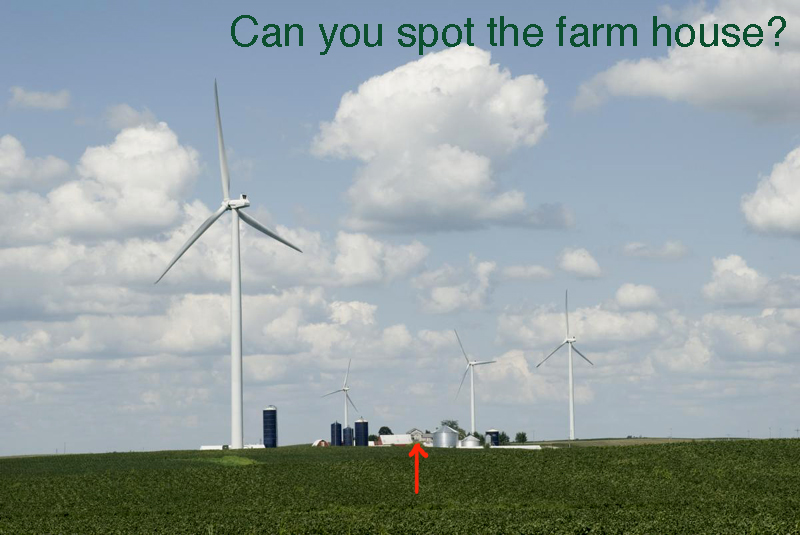
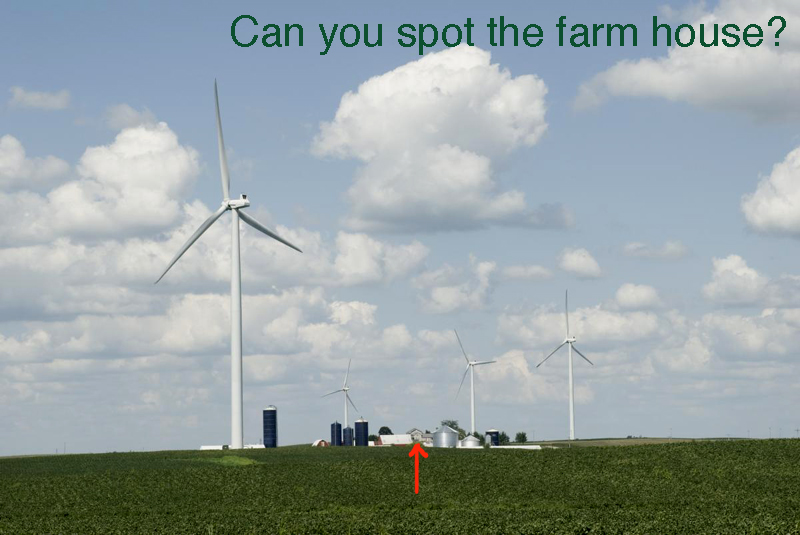
Wind turbines on a Wisconsin Farm
While I support the overall rule because it will promote the development of wind in Wisconsin, the rule fails to provide a much-needed safety net for people whose health declines because of a Wind Turbine located near their home.
-PSC Commissioner Lauren Azar
CLICK HERE TO DOWNLOAD THE FINAL WIND RULES FROM THE PUBLIC SERVICE COMMISSION
SOURCE: PSC DOCKET # 1-AC-231
From PSC commissioner Lauren Azar
To The Honorable Fred Risser The Honorable Michael Sheridan
The State Senate The State Assembly
State Capitol, Room 220 South State Capitol, Room 211 West
Madison, WI 53702 Madison, WI 53702
Re:Wind Siting Rules, Clearinghouse Rule 10-057
Dear Senate President Risser and Speaker Sheridan:
I write to explain my concurrence with the Commission’s rule on the siting of certain wind energy systems (Wind Turbines) in Wisconsin.
While I support the overall rule because it will promote the development of wind in Wisconsin, the rule fails to provide a much-needed safety net for people whose health declines because of a Wind Turbine located near their home.
The safety net I propose would be a minimal burden to wind developers while simultaneously protecting Wisconsin citizens who are sensitive to the noise emitted from Wind Turbines.
Among other things, 2009 Wisconsin Act 40 requires the Commission to develop rules that “provide reasonable protection from any health affects” associated with Wind Turbines. Wis. Stat. § 196.378(4g)(b).
There is substantial evidence that noise from Wind Turbines could negatively impact the health of a small percentage of the population.
To better ensure compliance with Act 40’s mandate, I proposed the following safety net: under limited circumstances, the owner of a Wind Turbine must purchase, at fair market value, the home of someone who can prove that a nearby Wind Turbine is directly causing a significant adverse health outcome. [1]
Unfortunately, at this time, we cannot accurately identify the precise line between safe levels of noise from Wind Turbines and those levels that will negatively affect human health.
Nor do we know why a small percentage of the population is affected more negatively by Wind Turbines than the rest of the population.
As new information becomes available, the Commission can revise this rule.
While more study is needed to better understand the full health impacts of Wind Turbines, it is important that we establish some remedy for the people who can prove that their health is being compromised by nearby Wind Turbines before the Commission has an opportunity to revise this rule.
To be clear, this safety net does not include awarding damages to the injured party; instead, it allows the injured party to move quickly from the area, thereby abating health concerns.
The safety net would be limited to landowners who provide evidence (in the form of a certification) from a licensed Wisconsin medical doctor that one or more Wind Turbines have directly caused a significant adverse health outcome on the injured party.
The only impact to the owner of the Wind Turbine(s) would be the need to resell the house.
Hence, the proposed safety net would not be an onerous requirement on the Wind Turbine owner and should not hamper wind development in Wisconsin.
The safety net could be structured as follows:
“PSC 128.XX Individual Hardships. If the owner of a nonparticipating residence experiences adverse health outcomes that are shown to be the direct result of the operation of a wind energy system, the owner of the nonparticipating residence may petition the political subdivision for mitigation of the adverse health outcomes.
The petition for mitigation shall be referred to the Commission, which may order mitigation of the adverse health outcomes.
A medical doctor licensed in the State of Wisconsin shall attest that that one or more wind turbine(s) have caused a significant adverse health outcome on the injured party before any relief may be granted under this section.
Mitigation may include requiring the owner of the wind energy system to purchase the nonparticipating residence at fair market value.
Note: The Wind Siting Council may make recommendations with respect to the form and type of information that is required to show that adverse health outcomes are the direct result of the operation of a wind energy system.
Absent a safety net provision like this, it is unclear how an injured party could obtain mitigation of adverse health outcomes from a Wind Turbine owner.
If they are unable to sell their property for fair market value, injured parties would be forced to file suit against the owner of a Wind Turbine.
This could require the injured party to incur significant legal costs that are not recoverable in a lawsuit and may dwarf the value of the home.
The State of Wisconsin should not place its citizens in this position.
In conclusion, while I concur with the rule as a package, I remain concerned that this rule fails to protect the most vulnerable of our community and, therefore, I must qualify my support of this important rule. When this rule is referred to the appropriate standing committees, please forward a copy of this letter with the rule.
Sincerely,
Lauren Azar
Commissioner
[1] The operation of this safety net proposal is not unprecedented. The Commission recently identified that the purchase of property at fair market value was a potential remedy for two landowners affected by a large wind energy development. Because the two landowners had a significant number of Wind Turbines within view from their homes, the Commission required mitigation, including the possibility that the utility purchase the properties at fair market value. The utility did not object to this potential remedy and has since purchased the properties.
SECOND FEATURE
In Wisconsin, Facts About ‘Green Job’ Creation Elusive as the Wind
SOURCE MacIver News Service | September 1, 2010
By Bill Osmulski
MacIver News Service Investigative Reporter
[Madison, Wisc...] Although they are touted and promoted by policy makers and opinion leaders across the state, accurately defining and keeping track of ‘green jobs’ has proven nearly impossible in Wisconsin.
Take, for example, ‘green jobs’ associated with the wind industry.

Wisc. Governor JimDoyle (D)
“Clean energy technology and high-end manufacturing are Wisconsin’s future,” Governor Jim Doyle said in his final State of the State address. “We have more than 300 companies and thousands of jobs in the wind industry.”
That statistic is impossible to verify.
The State of Wisconsin does not track those companies nor the jobs within the industry.
When contacted, the Office of Energy Independence (an agency created by Governor Doyle in 2007) directed MacIver News to Wisconsin Wind Works, a self-described “consortium of manufacturers representing the wind manufacturing supply chain within Wisconsin.”
The advocacy group maintains an online wind energy-related supply chain database, although a routine examination of the data proved just how unreliable the figures are.
When the online, searchable database was utilized earlier this summer, it listed 340 companies in Wisconsin connected to the wind industry, a fact which, without additional investigation would appear to be in line with the Governor’s statement.
However, further examination showed many of those companies were not currently serving the wind industry and were only listed because they someday could serve the wind industry.
For example, the database listed 38 manufacturers, but only 24 of them have anything to actually do with the wind energy sector presently.
Of those 24 Wisconsin manufacturers, only eight were categorized as primary suppliers.
Another four companies were listed as both primary and secondary suppliers. A MacIver News Service reporter contacted all eight primary suppliers and the four companies listed as primary/secondary suppliers in our initial query and what we found further eroded the credibility of Governor Doyle’s claims.
When contacted, the companies listed as both primary and secondary suppliers all described themselves merely as secondary suppliers. That means they produce products that are not exclusive to the wind energy.
For example, Bushman Equipment manufactures lifts that move heavy pieces of equipment, which, among many other uses, can be used to handle wind turbines.
Wisconsin Wind Works’ database is not only generous with the number of companies within their supply chain it associates as being primary suppliers, there are issues with the actual job numbers listed for each company as well.
Many of the figures are either inflated, the jobs are not located in Wisconsin, or they cannot be tied to wind energy.
For example, Rexnord Industries was one of the eight Wisconsin manufacturers listed in our query as directly serving the wind energy industry. The database shows the company has 6,000 employees.
Yet a Rexnord official told the MacIver News Service that the company only has 1,500 employees in Wisconsin, and only five of those have jobs which are directly tied to the wind industry.
Wisconsin Wind Works’ database says Orchid International has 600 employees, but a company spokesperson told MacIver it only has 150.
Amsoil Inc. in Superior has 236 employees listed in the Wisconsin Wind Works database, but a company representative told the MacIver News Service that only 6 of them work on wind energy-related products.
In all, at the time of our search, the database claimed 7,632 jobs among the eight manufacturers that were current primary suppliers to the wind industry. Yet, the MacIver News Service was only able to identify 31 jobs at those companies which were specifically tied to wind energy related products.
Manufacturers told MacIver News that other employees might work on wind-related products occasionally, but it does not represent the bulk of their workload.
Another 1,077 workers are listed among the secondary suppliers and we did not investigate that claim.
VAL-FAB, one of the companies listed as both a primary and secondary supplier, explained to MacIver News that it initially had high hopes for the wind energy industry that never materialized. The company specializes in fabrication for the energy sector.
William Capelle, Director of Business Development at VAL-FAB, said “At first we thought we might be able to manufacture the actual towers, but it turns out 90 percent of those are imported from Spain.”
Since the MacIver News Service first examined the Wisconsin Wind Works database, the number of companies listed has increased to 360.
A reporter attempted to contact the organization for comment about the veracity of their data, but Wisconsin wind Works, which solicits members by selling itself as the
“preferred partner of wind energy professionals,” did not respond.
They are, however, holding a Wind Energy Symposium in Milwaukee on October 13th.
Meanwhile the Office of Energy Independence continues to pursue the Doyle Administration’s green energy policies.
As Doyle said during his final State of the State address, “anyone who says there aren’t jobs in the clean energy economy had better open their eyes.”
There is no doubt that some jobs in the wind industry exist in Wisconsin. The accurate number of these ‘green jobs’ is proving to be, at best, elusive
Representatives of Doyle’s office did not respond to repeated request for comments regarding the information contained within this article.
THIRD FEATURE
What to expect when you're expecting wind turbines close to 500 feet tall:
Photos from the Town of Glenmore in Brown County Wisconsin
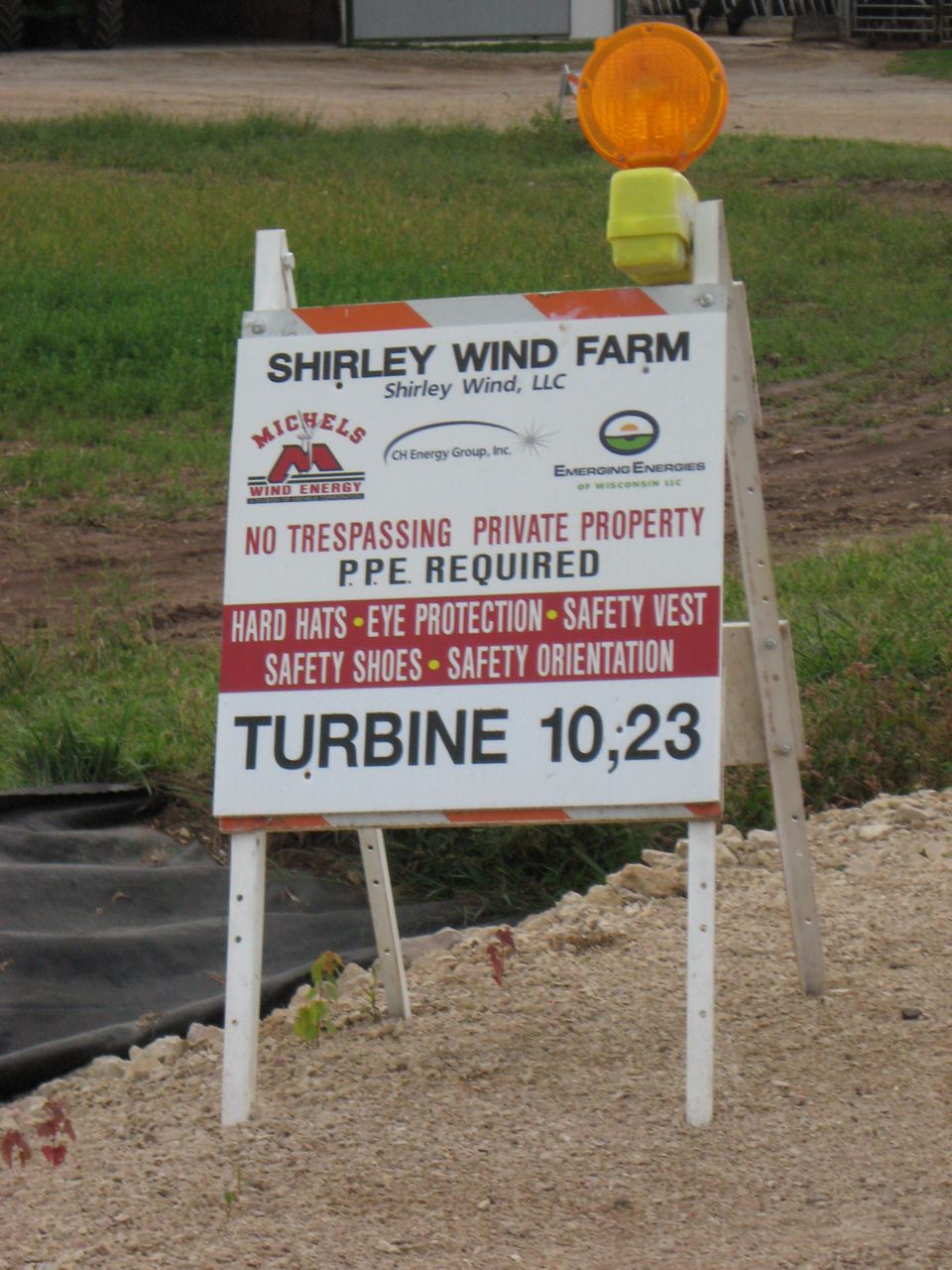

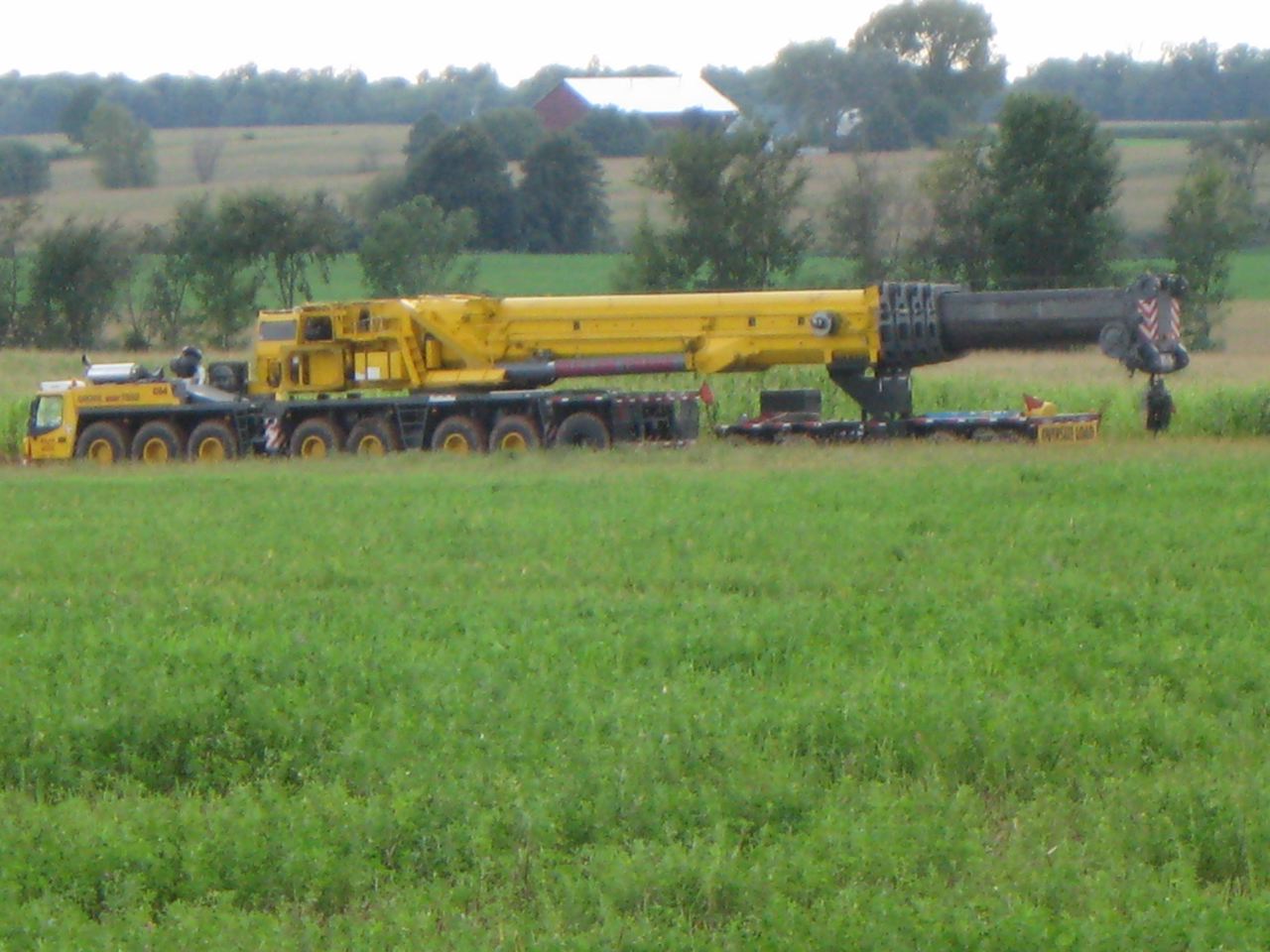

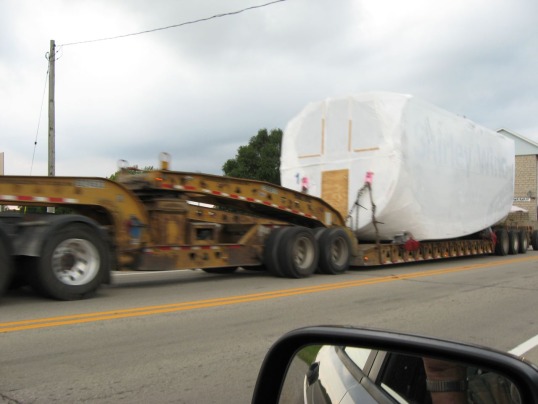




Construction underway on Brown Co. wind farm
8 turbines in Town of Glenmore
TOWN OF GLENMORE - Construction is underway on Brown County's first industrial wind farm. Eight wind turbines are being built in the Town of Glenmore in southern Brown County.
The developer, Wisconsin-based CH Shirley Wind, LLC, says construction is to be completed by the end of the year. The 8 wind turbines are expected to generate enough power to supply approximately 8,000 homes per year.
The wind turbines will stand 492 feet tall.
"We are hoping to generate power by the end of September on at least one turbine. Hopefully all 8 by the end of October," said John Roberts, the construction manager for the project.
The turbines will also provide some extra income for the four families hosting them on their properties.
"They're not just doing it for the money. They like the idea of being green and using their farm for something like this," said Roberts.
Though, like most wind developments, a number of neighbors aren't too happy with the project.
"The projects right now, with the setback rules we have, are just too close for people to live in that proximity to an electrical generator of that size," said Jamie Fletcher, who lives in the Town of Glenmore.
Fletcher has been working to stop all large-scale wind development in southern Brown County. She believes wind turbines cause health problems, mainly from all the noise they make.
"Insomnia, shadow flickers, causing everything from nauseasness to epileptic seizures and I don't want to put my family through that or my animals," said Fletcher.
However, a state committee that studied the issue recently found no health effects from the turbines. Those working on the project in Glenmore also say the turbines being built there have new technology that make them less noisy.
"They're a little bit higher and they turn a little bit slower and because they turn slower, there is actually less noise," said Roberts.
The Shirley Wind project is not part of a highly publicized proposal to build 100 wind turbines in several Brown County communities. That proposal, known as the Ledge Wind Energy Project, has not been voted on yet by the state Public Service Commission. It is being developed by a Chicago-based company called Invenergy.
Opponents, like Jamie Fletcher, say the 8 turbine project in Glenmore will be an example of why other projects should be stopped.
"Whatever happens out here, I pray it's a wake-up call for the rest of the state," she said.
Both sides will continue to debate whether wind development is what is best for Wisconsin.
THIRD FEATURE: A LETTER FROM MAINE:
Note: Like Wisconsin, Maine also passed law that streamlines wind siting for developers by removing local control and relaxing restrictions. Here is what Maine residents are saying two years later:
Though I’d suspected the news would eventually arrive, I still wasn’t ready when I got it.
Word came recently that a wind speed test tower, the harbinger of a future wind turbine development, would soon be erected just north of my property in Lexington Township.
Two more associated towers are to be located in Concord, the next township to the east.
My town is now among the unfortunate that have been infected with the virus of wind-energy sprawl. Industry activity, lately, has been substantial in our area and our town lies within the new expedited permitting zone. It was bound to happen.
I’ve been working to stop wind-sprawl on Maine’s rural landscape for almost a year.
However, until now, I’ve not known the full complement of the frustration, indignation and betrayal felt by so many Mainers seeing their lives turned upside down by the reckless and uncaring intrusion of this industry on their homes and property — all with the complicity of our state government.
I have worked beside many of these people for months, but only now do I fully understand their perspective.
My wife and I believed we’d spend the rest of our days in Lexington, living simply, and feeling fortunate to be surrounded by Maine’s unique beauty and the increasingly rare silence of a rural land.
The governor and Legislature, however, sealed our fate in 2008 when they gifted the wind industry with easy permitting terms for a scheme that is unlikely to produce benefits greater than what will be stolen from present and future generations.
Under the new laws, property owners have been left with little power to protect themselves. I will, nevertheless, continue to fight this industry’s assault on rural Maine, perhaps, with a keener awareness of what we stand to lose.
Alan Michka
Lexington

